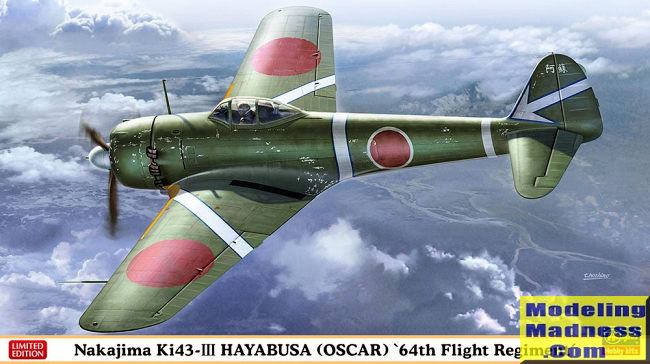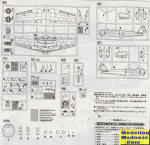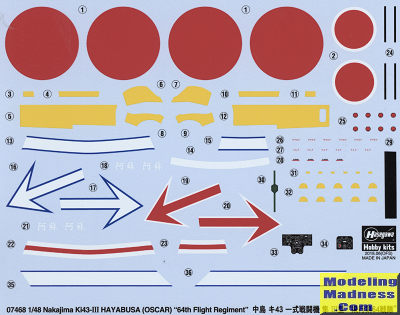
Hasegawa 1/48 Ki-43-III Hayabusa '64th Flight Regiment'
| KIT #: | 07468 |
| PRICE: | 4000 yen SRP |
| DECALS: | two options |
| REVIEWER: | Scott Van Aken |
| NOTES: | 2018 Limited Edition with resin parts |

| HISTORY |
| THE KIT |
 This is not their first Hayabusa boxing nor will it be their last. Hasegawa
has basic boxings of the Ki-43-I and of the Ki-43-II, but not of the later war
Ki-43-III. For that version, they rely on resin castings for a new cowling and
exhaust, hence a rather steep price for the variants. They are also not produced
very often so one needs to get them when one sees them available. They are not,
of course, the only Ki-43-III ever done with Fine Molds producing one as one of
their initial kits. However, the FM kit does not fit all that well as is
somewhat lacking in detailing compared to this one.
This is not their first Hayabusa boxing nor will it be their last. Hasegawa
has basic boxings of the Ki-43-I and of the Ki-43-II, but not of the later war
Ki-43-III. For that version, they rely on resin castings for a new cowling and
exhaust, hence a rather steep price for the variants. They are also not produced
very often so one needs to get them when one sees them available. They are not,
of course, the only Ki-43-III ever done with Fine Molds producing one as one of
their initial kits. However, the FM kit does not fit all that well as is
somewhat lacking in detailing compared to this one.
The 64th Flight Regiment is probably the first IJAAF unit to fully equip with the type and spent most, if not all the war in Burma/Indochina. Initially the unit was quite successful against Allied air power, but as the war progressed, superiority passed them by, as it did with most all Japanese units. By the time the Ki-43-III came around, it was a near-obsolescent type.
I have built quite a few 1/48 Ki-43s, most of them the Hasegawa boxing. The cockpit consists of a floor, forward and aft bulkhead, seat, stick, control column and rudder pedals. There are decals for the instrument panels and the cockpit has sidewalls that are inserted into the fuselage halves. One installs the cockpit from the underside so can join the fuselage halves as soon as the interior is painted. A polycap is used to hold the tail strut in place. Wings have separate tips and one needs to open some holes for the fuel tank pylons and carb intake.
The engine provided both rows as well as a gearbox/pushrod assembly. This latter piece holds a polycap for the prop shaft. The exhaust on this kit are resin castings and as they don't utilize the fuselage cut out, a resin filler piece is provided to close that slot. The exhaust fit into the same slots as the earlier variety. This is all covered by the new resin cowling.
 Landing
gear are quite nicely done with separate wheels and tire. The tires are
flattened on the bottom. Probably the 'worst' part of the kit is that the
butterfly flaps have to be posed extended. This is not at all prototypical and I
have ground away at the flap and flap well to have these items closed.
Landing
gear are quite nicely done with separate wheels and tire. The tires are
flattened on the bottom. Probably the 'worst' part of the kit is that the
butterfly flaps have to be posed extended. This is not at all prototypical and I
have ground away at the flap and flap well to have these items closed.
Instructions are standard stuff. Gunze paint references and well drawn construction steps. The two markings options are for planes that are in Nakajima army green over unpainted metal with yellow wing ID markings. The box art plane with the white bits is from Cambodia in 1945 while the other with the red bits was based in Burma during 1944. Both were flown by Hideo Miyabe. Decals are superbly printed and include the yellow wing ID markings.
| CONCLUSIONS |
Some of us would rather build an Oscar than a P-47 (for instance). For fans of the type, this is a nice addition and is probably the best -III done in this scale. I do wish Hasegawa would retool the lower wing to rid us of the extended combat flap, but that is not likely going to happen so it is back to the grinder and sandpaper.
| REFERENCES |
https://en.wikipedia.org/wiki/Nakajima_Ki-43
August 2018
Copyright ModelingMadness.com. All rights reserved. Thanks to my credit card for this one. If you would like your product reviewed fairly and fairly quickly, please contact the editor or see other details in the
Note to
Contributors. Back to the Main Page
Back to the Review
Index Page
Back to the Previews Index Page